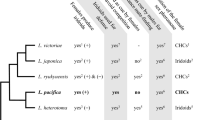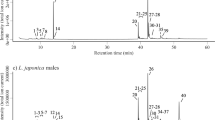Summary.
Hydroxydanaidal, the pyrrolizidine alkaloid-derived male corematal pheromone active in the close-range precopulatory interactions of the moth Utetheisa ornatrix, appears not to contribute to the chemical defense of this moth. The compound failed to manifest feeding deterrency as an additive to mealworms, in assays with a lycosid spider (Lycosa ceratiola). Moreover, contact with the male’s coremata, such as appears to occur inevitably in consequence of courtship in Utetheisa, does not in itself reduce the palatability of the female moth.
Similar content being viewed by others
Author information
Authors and Affiliations
Corresponding author
Rights and permissions
About this article
Cite this article
del Campo, M.L., Possner, S.T. & Eisner, T. Corematal function in Utetheisa ornatrix (Lepidoptera: Arctiidae): Hydroxydanaidal is devoid of intrinsic defensive potency. Chemoecology 17, 19–22 (2007). https://doi.org/10.1007/s00049-006-0353-9
Received:
Accepted:
Published:
Issue Date:
DOI: https://doi.org/10.1007/s00049-006-0353-9




